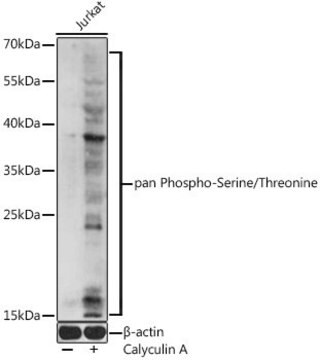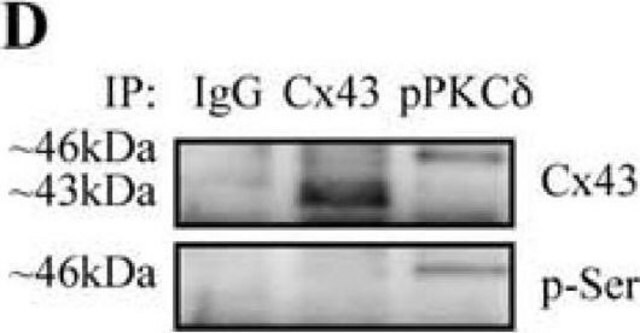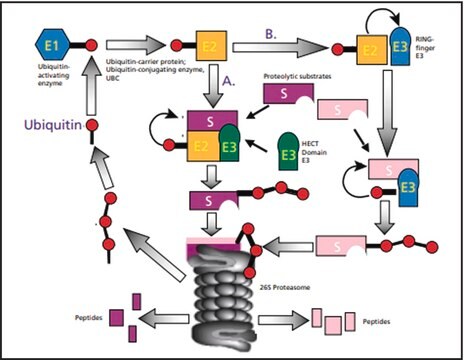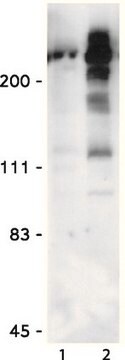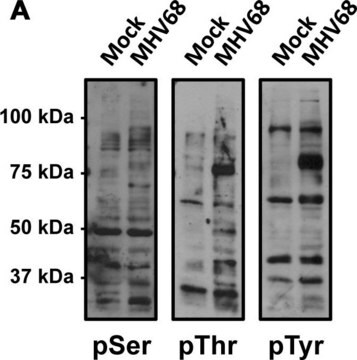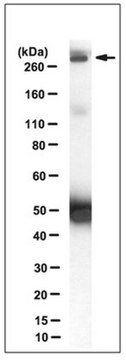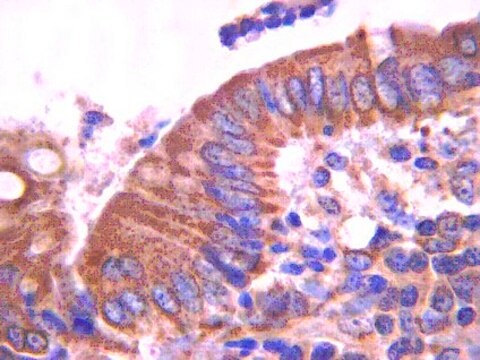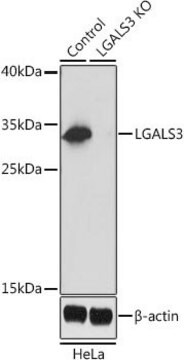05-368
Anti-phospho-Ser/Thr-Pro MPM-2 Antibody
clone MPM-2, Upstate®, from mouse
Synonym(s):
Phospho-Ser/Thr Antibody
Sign Into View Organizational & Contract Pricing
All Photos(7)
About This Item
UNSPSC Code:
12352203
eCl@ss:
32160702
NACRES:
NA.41
Recommended Products
biological source
mouse
Quality Level
antibody form
purified immunoglobulin
clone
MPM-2, monoclonal
species reactivity
vertebrates
manufacturer/tradename
Upstate®
technique(s)
ELISA: suitable
immunohistochemistry: suitable
immunoprecipitation (IP): suitable
western blot: suitable
isotype
IgG1
shipped in
wet ice
target post-translational modification
phosphorylation (pSer/pThr)
General description
This antibody recognizes a variety of proteins that are phosphorylated during mitosis.
Upon entry into M (Mitosis) phase, many proteins are phosphorylated either directly or indirectly by M-phase-promoting factor (MPF). The MPM2 monoclonal antibody binds to a phospho amino acid-containing epitope (peptides containing LTPLK and FTPLQ domains) present on more than 50 proteins of M-phase eukaryotic cells.
Specificity
Recognizes phosphorylated serines or threonines when followed by a proline.
Immunogen
Mitotic human HeLa cell cytosolic lysate
Application
Anti-phospho-Ser/Thr-Pro MPM-2 Antibody is a Mouse Monoclonal Antibody for detection of phospho-Ser/Thr-Pro also known as Mitotic protein #2 & has been tested in ELISA, IHC, IP & WB.
Research Category
Epigenetics & Nuclear Function
Epigenetics & Nuclear Function
Research Sub Category
Cell Cycle, DNA Replication & Repair
Cell Cycle, DNA Replication & Repair
Quality
routinely evaluated in immunoblot on colcemid treated human HeLa carcinoma cells
Target description
varies depending on the protein you are detecting
Physical form
Format: Purified
Protein G Purified
Protein G Purified immunoglobulin in Protein G Purified immunoglobulin in 30% glycerol, 0.07M Tris-glycine, pH 7.4, 0.105 M NaCl, 0.035% sodium azide as a preservative.
Storage and Stability
Maintain for 2 years at -20°C from date of shipment. Aliquot to avoid repeated freezing and thawing. For maximum recovery of product, centrifuge the original vial after thawing and prior to removing the cap.
Analysis Note
Control
Colcemid treated HeLa cell lysate or A431 mitotic cells fixed with 3.7% paraformaldehyde
Colcemid treated HeLa cell lysate or A431 mitotic cells fixed with 3.7% paraformaldehyde
Other Notes
Concentration: Please refer to the Certificate of Analysis for the lot-specific concentration.
Legal Information
UPSTATE is a registered trademark of Merck KGaA, Darmstadt, Germany
Disclaimer
Unless otherwise stated in our catalog or other company documentation accompanying the product(s), our products are intended for research use only and are not to be used for any other purpose, which includes but is not limited to, unauthorized commercial uses, in vitro diagnostic uses, ex vivo or in vivo therapeutic uses or any type of consumption or application to humans or animals.
Storage Class Code
10 - Combustible liquids
WGK
WGK 1
Certificates of Analysis (COA)
Search for Certificates of Analysis (COA) by entering the products Lot/Batch Number. Lot and Batch Numbers can be found on a product’s label following the words ‘Lot’ or ‘Batch’.
Already Own This Product?
Find documentation for the products that you have recently purchased in the Document Library.
S A Innocente et al.
Proceedings of the National Academy of Sciences of the United States of America, 96(5), 2147-2152 (1999-03-03)
The p53 tumor suppressor controls multiple cell cycle checkpoints regulating the mammalian response to DNA damage. To identify the mechanism by which p53 regulates G2, we have derived a human ovarian cell that undergoes p53-dependent G2 arrest at 32 degrees
J Cobb et al.
Developmental biology, 205(1), 49-64 (1999-01-12)
Little is known about the timing of meiotic prophase events during spermatogenesis in the mouse or how these events are related to cell-cycle progression. This work was designed to test hypotheses about the timing and biochemical correlates of developmental acquisition
Cyclin E controls Drosophila female germline stem cell maintenance independently of its role in proliferation by modulating responsiveness to niche signals.
Ables, ET; Drummond-Barbosa, D
Development null
Mitotic mechanisms in Alzheimer's disease?
Vincent, I., et al
The Journal of cell biology, 132, 413-425 (1996)
Orally active microtubule-targeting agent, MPT0B271, for the treatment of human non-small cell lung cancer, alone and in combination with erlotinib.
Tsai, AC; Wang, CY; Liou, JP; Pai, HC; Hsiao, CJ; Chang, JY; Wang, JC; Teng, CM; Pan, SL
Cell Death & Disease null
Our team of scientists has experience in all areas of research including Life Science, Material Science, Chemical Synthesis, Chromatography, Analytical and many others.
Contact Technical Service